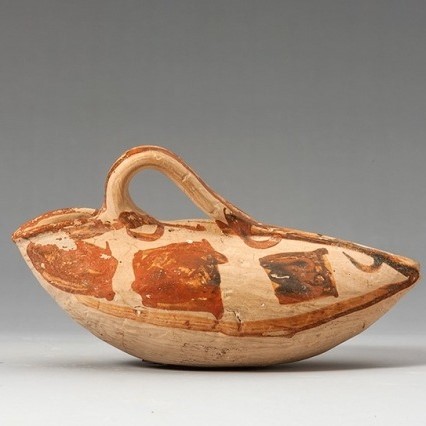
Artefact or object:
Description:
Mycenaean Pottery
Introduction by J.R. Green
The Mycenaeans were finally proved to be Greeks by the decipherment of Linear B in 1952. They had arrived in what we now call Greece about the turn of the second millennium bc and quickly developed a distinctive style of which one aspect is its pottery. The development of the palace culture seems to have occurred around the time of the transition from what is termed Middle to Late Helladic, in the 16th century, and there is evidence of a successively more centralised political system until its collapse around 1200 BC.
Decorated Late Helladic pottery is finely made with well-worked clay produced on a fast wheel. The applied paint is typically a glossy red-brown, often characterised by neat brushwork. The extent of Mycenaean external contacts is demonstrated by the wide distribution of the pottery in Cyprus, the Near East and Egypt (which has provided the best evidence for its chronology), and then in the West in South Italy, Sicily, the Aeolian Islands, Etruria, Sardinia, and even as far as Spain. Indeed there seems to have been local production in South Italy, as there clearly was in Cyprus.
The first serious study of Mycenaean pottery was that by Adolf Furtwängler and Georg Loeschcke, Mykenische Vasen: vorhellenische Thongefässe aus dem Gebiete des Mittelmeeres (Berlin 1886). The next major step was the classificatory work of A. Furumark, The Mycenean Pottery. Analysis and Classification (Stockholm 1941) and The Chronology of Mycenean Pottery (Stockholm 1941), and they have only recently begun to fall out of general use. During the 1960s E.B. French published a series of vital articles in BSA establishing a finer sequence based on stratified deposits from Mycenae, and many other regional studies have appeared since. The main items are listed in the bibliographies of the two useful handbooks by P.A. Mountjoy, Mycenaean Decorated Pottery. A Guide to Identification (Studies in Mediterranean Archaeology vol. 73, Göteborg 1986) and Mycenaean Pottery: An Introduction (Oxford University Committee for Archaeology Monograph no. 36, Oxford 1993).
Those interested in issues of trade and contact should consult C. Zerner, P. Zerner and J. Winder (eds.), Wace and Blegen. Pottery as Evidence for Trade in the Aegean Bronze Age, 1939-1989. Proceedings of the International Conference, Athens 1989 (Amsterdam 1993). On chronological issues, P. Warren and V. Hankey, Aegean Bronze Age Chronology (Bristol 1989) is vital.
See also the Mycenaean terracotta figurines, under ‘Terracottas’.